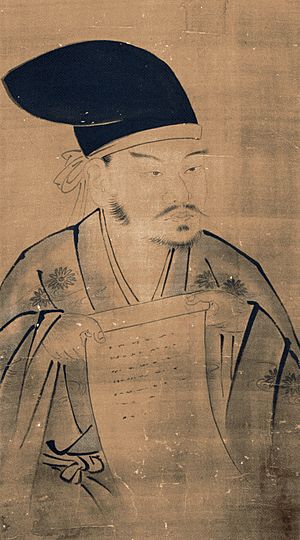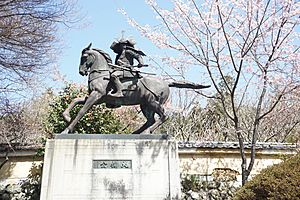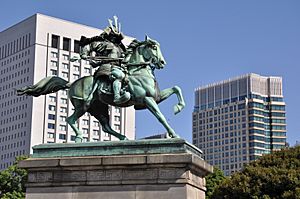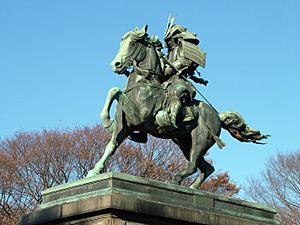Kusunoki Masashige facts for kids
Quick facts for kids
Kusunoki Masashige
|
|
|---|---|
| 楠木 正成 | |

Portrait of Kusunoki Masashige by Kanō Sanraku, c. before 1635
|
|
| Born | 1294 |
| Died | 4 July 1336 (aged 41–42) |
| Resting place | Kanshin-ji |
| Monuments | Hōken-tō Various statues |
| Nationality | Japanese |
| Other names | Dai Nankō, Hyōe-no-Jō, Saemon-no-Jō, Jō |
| Occupation | Samurai |
| Known for | Overthrowing the Kamakura shogunate, ideal samurai loyalty |
Kusunoki Masashige (楠木 正成, 1294 – 4 July 1336) was a famous Japanese samurai warrior. He lived during the Kamakura period and is remembered as the perfect example of samurai loyalty.
Kusunoki fought for Emperor Go-Daigo. Their goal was to overthrow the powerful Kamakura shogunate (a military government). They wanted to bring power back to the Emperor in Kyoto. Kusunoki was a key leader in this effort, known as the Kenmu Restoration in 1333.
He stayed loyal to Emperor Go-Daigo even when another general, Ashikaga Takauji, turned against the Emperor. Kusunoki bravely fought Takauji's larger army, knowing he would likely lose. He died in the Battle of Minatogawa in 1336.
Kusunoki became a popular legend in Japan. He represents loyalty and courage. He is linked to the famous phrase: "Would that I had seven lives to give for my country!" (七生報國; Shichishō Hōkoku!). More than 500 years after his death, the Meiji government honored him with Japan's highest court rank in 1880.
Contents
Kusunoki Masashige's Early Life
We don't know much for sure about Kusunoki Masashige's early life. His military career lasted only six years, from 1331 until his death in 1336.
Kusunoki was likely born in 1294 in Kawachi Province. He probably came from a well-off family in the countryside. Some say he was a descendant of Tachibana no Moroe, a famous nobleman from the 700s. A small monument marks his believed birthplace in Chihaya-Akasaka village.
Kusunoki was a "scholar and a devout Buddhist". He received much of his early education at Kanshin-ji Temple. This temple is in Kawachinagano, in what is now southern Osaka Prefecture. Later in his life, Kusunoki helped renovate the temple. While studying there, he often visited central Kawachinagano. He learned military strategy from a man named Oe Tokichika.
A famous story says Emperor Go-Daigo had a dream. In the dream, he was safe under a camphor tree. The Japanese word for camphor tree is "kusunoki". This dream supposedly led the Emperor to the warrior who would support him.
Kusunoki's Military Career
Kusunoki was a brilliant military leader. He was known for his clever tactics and strategies. His skillful defense of two important fortresses helped Emperor Go-Daigo. These were the Siege of Akasaka and the Siege of Chihaya. These victories allowed the Emperor to briefly regain power.
In 1333, Emperor Go-Daigo rewarded Kusunoki Masashige. He made him governor of Settsu Province and Kawachi Province. Kusunoki was also promoted to a high rank. He later worked in important government offices.
However, one of the Emperor's generals, Ashikaga Takauji, turned against him. Takauji led an army to fight Kusunoki and the remaining loyalists. Takauji managed to capture Kyoto for a short time. But Kusunoki and another general, Nitta Yoshisada, forced him to flee.
By 1336, Takauji was a threat to Kyoto again. Kusunoki suggested a plan to the Emperor. He advised them to hide on sacred Mount Hiei. They would let Takauji take Kyoto. Then, they would attack from the mountain with the help of monks. This would trap Takauji in the city and defeat him.
Emperor Go-Daigo did not want to leave the capital. He insisted that Kusunoki fight Takauji's larger army directly. Kusunoki knew this was a very risky command. But, showing ultimate samurai loyalty, he obeyed his Emperor. He marched his army into what he knew was almost certain defeat.
The battle happened at Minatogawa, near modern-day Kobe. It was a terrible defeat for Kusunoki. He and his army were completely surrounded. Only about 50 of his original 700 horsemen were left.
According to legend, Kusunoki's brother, Kusunoki Masasue, spoke his last words: Shichishō Hōkoku! ("Would that I had seven lives to give for my country!"). Kusunoki Masashige agreed with him. After his death, his head was removed and sent to Kanshin-ji. It was buried there in a special mound.

Kusunoki also built several smaller castles in southern Osaka. These included Eboshigata Castle and Ishibotoke Castle. They were built along the Koya Kaido, a popular pilgrimage route. These castles protected the trail from bandits. They also provided income and information. Travelers had to pay a toll, and the castle guards would listen for news from around Japan.
Kusunoki's Lasting Legacy
Kusunoki's son, Kusunoki Masatsura, continued his father's loyalty. He served the new young emperor, Emperor Go-Murakami. This relationship showed the same trust and devotion as his father's. Masatsura kept the spirit of loyal resistance alive.
Masatsura died in battle along with his brother and cousin. This battle marked the end of the Kusunoki clan. After this, there was a struggle for power among the different courts.
Kusunoki "stands in the history of his country as the ideal figure of a warrior." He showed great civil and military virtues.
The story of Masashige saying goodbye to his son was very popular. It was taught in all elementary schools in Japan before World War II. It was also the subject of a patriotic song.
The Legend of Nankō
After the Tokugawa shogunate introduced Neo-Confucianism as a state philosophy, Kusunoki Masashige's image changed. He had once been called a traitor by some. But during the Edo period, scholars and samurai influenced by Neo-Confucian ideas made him a hero.
They called him Nankō (楠公) or Dai Nankō (大楠公). He became a symbol of loyalty, courage, and devotion to the Emperor. In 1871, Minatogawa Shrine was built to honor his spirit. Kusunoki later became a special hero for World War II kamikaze pilots. They saw themselves as his spiritual followers, sacrificing their lives for the Emperor.
Family
Kusunoki Masashige had several children:
- Kusunoki Masatsura
- Kusunoki Masanori
- Kusunoki Masatoki
Honors
- Senior First Rank (awarded posthumously on July 20, 1880)
See also
 In Spanish: Kusunoki Masashige para niños
In Spanish: Kusunoki Masashige para niños
- Nathan Hale— An American Patriot and spy during the American Revolutionary War. He was captured by the British and executed. His last words were, "I only regret that I have but one life to lose for my country." This quote is similar to Kusunoki's, but Nathan Hale was likely quoting a play by Joseph Addison.



